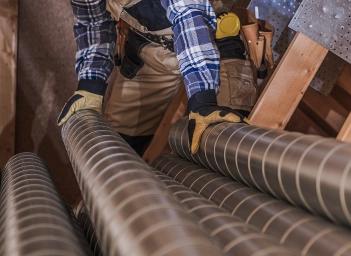Is a Whole-House Ventilator Right for Your Home?
Summary: Maybe. In this article, you’ll learn about signs you need better ventilation, what a whole-house ventilation system is, the different types, how one works, what one costs, and how to schedule an air quality evaluation.
By Anne Fonda
The V in HVAC stands for ventilation, with the full acronym meaning heating, ventilation, and air conditioning. Most of us think more about how cool the AC or heat pump keeps us in summer or how warm the furnace or heat pump keeps us in winter. But we don’t think a lot about ventilation. But we should, because poor ventilation can affect your indoor air quality (IAQ)and your health.
What are some signs of poor ventilation?
It helps if you learn to recognize the signs of poor ventilation. They include
- Stale indoor air
- Pet odors that permeate the home
- Cooking smells that linger hours after a meal
- Musty smell
- Excessive humidity
- Mold and mildew growth
- Frequent headaches
- Respiratory symptoms (nasal congestion, cough, etc.)
- Eye irritation
Some of these signs may be caused by something other than poor ventilation. But if you experience any of these things in your home, you may want to think about improving airflow.
If smells and some symptoms go away when you open windows or screen doors, you need better ventilation. In older homes, cracks and gaps around windows, doors, the roof, and more can let odors and fumes escape. But you may not be bringing in enough fresh air.
But in newer, more tightly sealed homes, or homes with upgraded insulation, windows, and doors, the home may not “breathe” as well. The solution may be a whole-house ventilation system. In some new homes, such a system may be required by building ventilation codes.
What is a whole-house ventilation system?
A whole-house ventilation system is a mechanical ventilation system that expels stale air and replaces it with fresh, outdoor air. The ventilator can provide constant ventilation, whether your HVAC system is running or not.
Is a whole-house ventilator the same as a whole-house fan?
No. This is a misconception. Whole-house fans, or attic fans, are usually installed in attics. They help remove hot air in the summer. They may draw in cooler air at night.
Modern whole-house ventilators perform air exchange, as well as help regulate humidity, and can even recover energy. They also filter the outdoor air, ensuring no pollutants enter through the ventilation system.
What are the types of whole-house ventilators?
There are two main types of whole-house ventilators – the heat recovery ventilator (HRV) and the energy recovery ventilator (ERV). Let’s explore the features and differences between the two.

Energy recovery ventilator (ERV)
In addition to removing stale air and providing fresh, outdoor air, an energy recovery ventilator provides humidity control. During the air transfer process, it removes humidity from the incoming air in the summer and adds humidity to the dry air in the winter. This can make your home feel cooler in the summer and warmer in the winter, without touching the thermostat. ERVs are great if you have high humidity in the summer or year-round and if you have cold, dry winters.
But wait! There’s more. As the name implies, an ERV takes things a step further. An energy recovery ventilation system uses a heat exchanger to recover residual heat left in the furnace exhaust or air handler exhaust in the winter and uses it to warm the cool outdoor air before sending it into the HVAC system.
In summer, the ERV cools down fresh air it brings in before sending it through to your HVAC system. This heat energy recovery can help reduce the amount of energy your HVAC system uses to heat or cool your home. That can mean reduced energy consumption and lower energy costs.
Our Premium ERV has been tested to confirm it has an Adjusted Sensible Recovery Efficiency up to 88%, meaning it recovers up to 88% of heat energy to warm or cool incoming air.
Heat recovery ventilator
Like an ERV, a heat recovery ventilation system recovers heat from the outgoing air to warm or cool incoming air. This can improve your HVAC system’s energy efficiency, potentially reducing your heating and cooling bills.
But that’s where the similarities end. A standard heat recovery system does not provide humidity control. That means if an HRV is running in the summer, it will bring in all the humidity, making your air conditioner work harder. If your summers are dry with low humidity, an HRV might be suitable.
Do I need a whole-house ventilation system?
Local building codes may require a whole-house ventilation system in new homes. You may want to consider one if you experience some of the signs of poor ventilation we mentioned above. You can monitor your home’s air quality with the Awair Element, which you can connect to your Trane system.
You can also schedule an air quality evaluation to see how healthy or unhealthy the air inside your home is, and your options to improve indoor air quality.
How much does a whole-house ventilation system cost?
This will depend on the model you get and where you live. Whole-house ventilators designed to serve larger homes may cost more than units designed for a smaller area, for example. In addition, an ERV will cost more than an HRV because of the added benefits. You will also need to pay for professional installation.
On average, you can expect a whole-house energy recovery ventilator to cost between $1,900 and $2,500 installed. You may be able to save money on labor costs by installing a whole-house ventilation system at the same time as you schedule HVAC replacement rather than during a separate appointment.
Work with the indoor air quality experts
Work with heating, ventilation, and air conditioning experts to help increase total home comfort as well as potentially save on your energy bills. Schedule an indoor air quality evaluation with your local Trane dealer today.
Anne Fonda, Content Writer
A Content Writer with Trane Technologies, Anne Fonda researches topics and writes for Trane® and associated residential HVAC brands. She works in collaboration with Trane Technologies subject matter experts, offering easy-to-understand, informative content on complex topics. Her goal is to help consumers make informed decisions on the products and services they need.
She has written for HVAC and other service provider websites for over 16 years. Before transitioning to web content writing, Anne had a 14-year stint as an award-winning journalist. She graduated cum laude from the University of Missouri-Columbia School of Journalism.
When she’s not working, Anne enjoys playing word games, reading, gardening, spending time with family, and visiting gardens and museums.
Expert review by Sean Goddard, Product Manager, Coils & Indoor Air Quality
Related Articles




